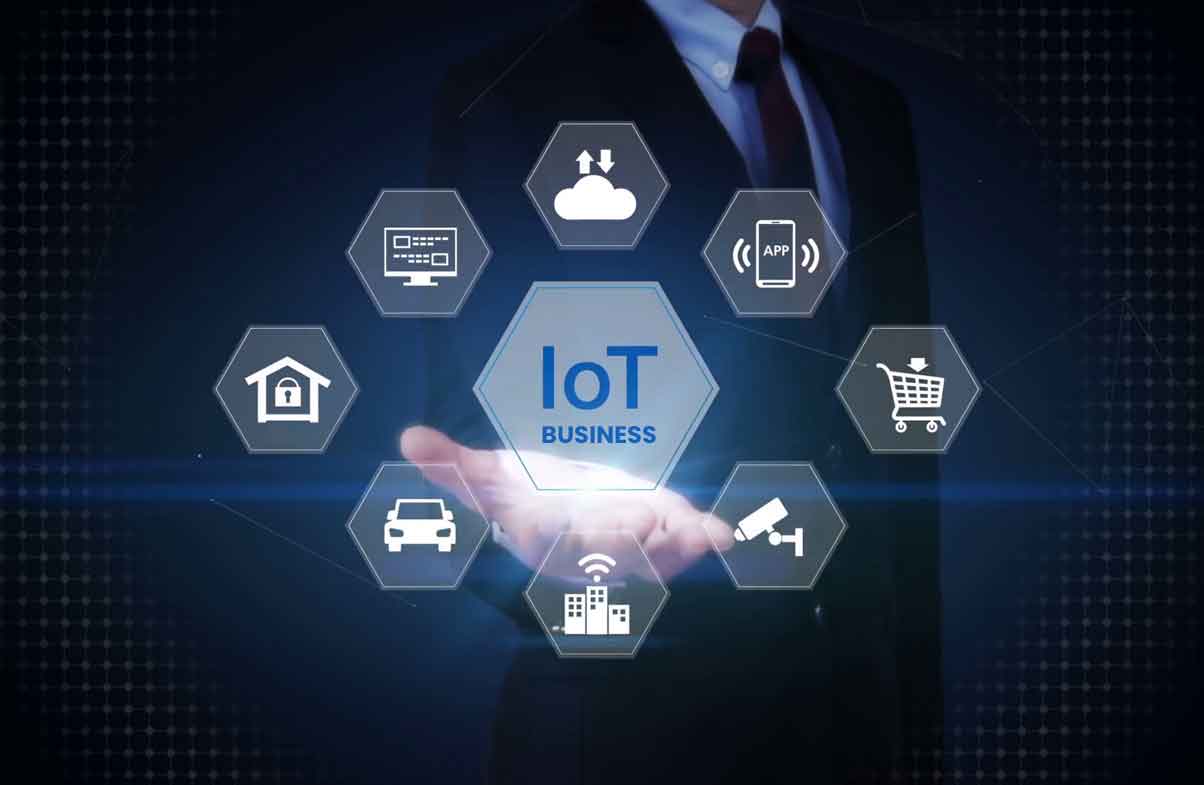How to Implement IoT in Your Business: A Step-by-Step Guide

09 Jan 2025
How to Implement IoT in Your Business: A Step-by-Step Guide
The way of conducting every business is different today because it has made things more efficient but intelligent in collecting data, optimizing operations, and increasing customer satisfaction-the Internet of Things (IoT). In other words, the scope of intelligence that IoT provides for machines, sensors, and devices comes with connectivity and communication, and the ability to share in the proper context vital insights and automation potential. Well, from a mega business to a small startup, all that you need is the Internet of Things, and it will change your company.
In this blog we will explore the step-by-step procedure of how to implement IoT in your business, so let’s start.
Steps of Implementing IoT in Your Business
Integrating IoT in your business is essential for companies to stay competitive, so let’s delve into the step-by-step procedure of how to implement IoT in your business.
1. Identify Business Objectives
The first, and most significant step for any organization to take when it comes to IoT is realizing its objectives for the business. What is it that you're seeking to accomplish with IoT? Here are some particular examples of frequent objectives:
Operational Efficiency
Reduce waste and automate tasks, increasing productivity.Customer Experience
Personalizing and updating clients in real-time.Cost Reduction
Asset monitoring, predictive maintenance, and resource optimization.Data-Driven Insights
Improve decision-making and forecasting with real-time data.
Assess your business processes and list down all the known challenges that IoT can solve. Clear objectives would mean that you would be able to prioritize the needed use cases and guide the journey toward IoT implementation.
2. Assess Your Existing Infrastructure
With your objectives specified, you could go ahead and check your present infrastructure to see if they will serve to support the IoT implementations. What would you want to consider in this evaluation?
The Network Infrastructure:
Is your network solid enough to support the whole data that would be generated by IoT devices? Actually, Wi-Fi, Bluetooth, and cellular networks are just some of the types that IoT devices may use for connectivity.Data Storage:
An IoT device collects enormous amounts of data. Make sure that the company has sufficient storage space available, whether on-premises or in the cloud.Security:
These devices can be attacked via cyberspace. Ensure that your business is well fortified with security features, along with encryption and regular software updates.
This comprises a solid backbone of the infrastructure that ought to be established so that IoT facilities can function smoothly in your business context.
3. Choose the Right IoT Devices and Sensors
These devices and sensors are entirely your own IoT backbone. Aptly choose them as per your business objectives. For instance:
Smart Sensors:
Monitors changes in temperature, humidity, and movement, along with other physical factors in real-time. Most suitable for industries such as manufacturing, agriculture, and logistics.Wearables:
Wearables are an option for tracking employee or customer health data, aiding real-time location tracking, or monitoring performance.Connecting Machines:
Industrial IoT applications make machines connect for predictive maintenance, performance monitoring, and automation.Smart Appliances:
Such IoT appliances can improve customer efficiency by automating processes like ordering supplies or adjusting room conditions in retail or hospitality industries.
Select the devices that best suit your needs and integrate them into your already existing systems without a hitch.
4. Ensure Data Security
A critical consideration is security during the IoT implementation stage too. Since the organization's vast volumes of sensitive data are generated, businesses must act to secure their IoT devices and data. The following must be followed:
Encryption:
Encrypt all data while it is being transmitted and at rest.Firewalls and VPNs:
Build firewalls to block unauthorized users from accessing your IoT network, then implement Virtual Private Networks (VPNs) for secure connections.Regular Updates of Software:
Update your IoT device's firmware and software regularly for protection against exploitable vulnerabilities.Access Control:
Tight access control should ensure no person other than the authorized ones access the sensitive data.
IoT devices become the gateways through which cybercriminals infiltrate; hence, it will be necessary to consider that data security becomes prominent.
5. Integrate IoT with Existing Systems
Maximizing the potential of IoT requires connecting it to existing systems such as:
Enterprise Resource Planning (ERP):
Integration with ERP systems could enable automation of workflows, better inventory control, and optimized resource allocation through IoT.Customer Relationship Management (CRM):
All the information from IoT combined with that of CRM systems will make customers even better serviced and individualized interactions for customers thus improving engagements.Supply Chain Management (SCM):
The supply chain with IoT shows benefits such as real-time tracking of goods and predictive analysis for inventory management.
Integrating IoT data onto these additional platforms enhances the operational efficiency of all of these processes and the decision-making complex.
6. Leverage Data Analytics
The inner worth of IoT lies in the data it generates. However, raw data itself is useless unless it gets analyzed and turned into actionable insights. Use advanced analytics platforms to:
Predict Trends:
Predictive analytics help businesses foresee potential issues and mitigate risks before they strike.Optimize Operations:
Data analysis helps identify inefficiencies in processes and suggests areas for improvement.Personalized Offerings:
Personalized recommendations and services through behavior data derived from analyzing data from IoT devices.
Analytics allow you to tap into the immense potential of IoT data to make informed decisions and drive business growth.
7. Test and Pilot the System
Before a full-scale rollout, it’s important to test your IoT system in a controlled environment. A pilot program allows you to:
Identify Issues:
Detect any compatibility issues, glitches, or inefficiencies that might arise during implementation.Refine the System:
Based on feedback from the pilot program, refine the IoT devices, network infrastructure, and software integration to ensure everything works smoothly.Evaluate ROI:
Assess whether the IoT system is delivering the desired results in terms of efficiency, cost savings, and productivity.
Testing helps ensure that the IoT system will function optimally when fully implemented.
8. Scale and Optimize
Once the preliminary project of the IoT system is completed successfully, you will be able to scale it into other areas of your business. When it is scaled:
Monitor Performance:
Ensure constant monitoring of the performance of your IoT devices and systems to confirm their alignment with the business target.Optimize Operations:
Continue amending IoT data towards operation improvement and maximum productivity with minimum cost.Expand Uses:
Discover, as time goes on, other use cases and applications to be piloted through IoT.
The scalability would enable encompassing everything in IoT within the entire business.
9. Stay Updated on IoT Trends
The Internet of Things IoT is constantly evolving. You must be up to date on the latest gadgets, technologies, and industry best practices. Assess your IoT systems' performance regularly and take any required action to maintain your competitive edge. Determine which emerging trends, like 5G, edge computing, and artificial intelligence integration, will contribute to the development of IoT and open up even more fantastic avenues for creativity.
Conclusion
It is likely that IoT implementation within your industry can boost efficiency, productivity levels, and satisfaction among customers. The only steps are to define objectives and goals, select appliances, secure those appliances, and connect them with existing systems in order to incorporate them into IoT. Such meticulous planning and execution can turn IoT into a very powerful instrument to transform one's business.
At NanoByte Technologies, we assist businesses in integrating IoT services into their existing processes to enhance operational efficiency and overall workflow.
Frequently Asked Questions (FAQs)
1. What are the benefits of implementing IoT in business?
Implementation of IoT in business can lead to an increase in operational efficiency, enhance customer experience, better decision-making through data insight, and reduce costs through automation and predictive maintenance.
2. What industries can IoT hit?
IoT can hit a very large range of industries, namely manufacturing, healthcare, logistics, agriculture, retail, and hospitality. All these different industries have their own specialized uses for IoT, such as predictive maintenance, smart supply chain, and customer engagement.
3. What is the range of costs incurred in implementing IoT?
Costing on the IoT implementation may vary according to different scales of the project you are undertaking, device types and the number of devices used, and the level of complexity in your infrastructure. Start small with pilot projects where the initial outlay is minimized, and then roll out more gradually to get a measure of value.
4. What are some of the challenges expected when implementing IoT?
Among the common challenges that most organizations have while implementing IoT are the integration with existing systems, data security, device compatibility, and, most especially, the large amounts of data generated. Proper planning and choosing the right technology partners can mitigate these challenges.
5. In what way can IoT improve customer service?
IoT can improve customer service by creating more personalized experiences, keeping them in real-time, thereby increasing product availability. For example, smart devices will act by keeping records of user behaviors and then providing recommendations or notifications based on customer preferences.




.jpeg)
